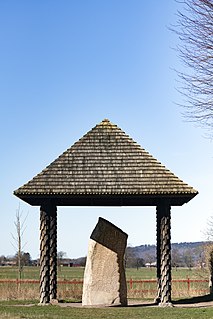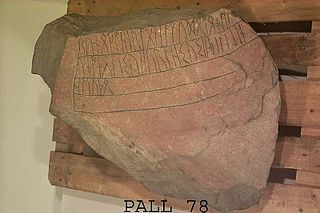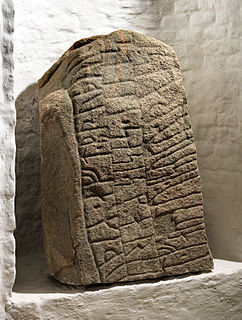
The Rök runestone is one of the most famous runestones, featuring the longest known runic inscription in stone. It can now be seen beside the church in Rök, Ödeshög Municipality, Östergötland, Sweden. It is considered the first piece of written Swedish literature and thus it marks the beginning of the history of Swedish literature.

Monument of Neutrality is a monument originally located in Ashgabat, Turkmenistan. In 2010 it was moved to the suburbs. The three-legged arch, which became known locally as "The Tripod", was 75 metres (246 ft) tall and was built in 1998 on the orders of Turkmenistan's President Saparmurat Niyazov to commemorate the country's official position of neutrality. It cost $12 million to construct. The monument was topped by a 12-metre (39 ft) tall gold-plated statue of Niyazov which rotated always to face the sun. The arch was located in central Ashgabat where it dominated the skyline, being taller than the nearby Presidential Palace. The statue was illuminated at night. The arch featured a panoramic viewing platform which was a popular attraction for visitors.

The Sparlösa Runestone, listed as Vg 119 in the Rundata catalog, is located in Västergötland and is the second most famous Swedish runestone after the Rök runestone.

The Saleby Runestone, designated as Vg 67 in the Rundata catalog, was originally located in Saleby, Västra Götaland County, Sweden, which is in the historic province of Västergötland, and is one of the few runestones that is raised in memory of a woman.
The Ingvar Runestones is the name of around 26 Varangian Runestones that were raised in commemoration of those who died in the Swedish Viking expedition to the Caspian Sea of Ingvar the Far-Travelled.

The Rö runestone, designated under Rundata as Bo KJ73 U, is one of Sweden's oldest and most notable runestones.
The Järsberg Runestone is a runestone in the elder futhark near Kristinehamn in Värmland, Sweden.

The Möjbro Runestone is a runestone that is designated as U 877 in the Rundata catalog and is inscribed in Proto-Norse using the Elder Futhark. It was found in Möjbro, which is about 8 kilometers north of Örsundsbro in Uppsala County, Sweden, which is in the historic province of Uppland. The runestone is on display at the Swedish Museum of National Antiquities in Stockholm.
The Greece runestones are about 30 runestones containing information related to voyages made by Norsemen to the Byzantine Empire. They were made during the Viking Age until about 1100 and were engraved in the Old Norse language with Scandinavian runes. All the stones have been found in modern-day Sweden, the majority in Uppland and Södermanland. Most were inscribed in memory of members of the Varangian Guard who never returned home, but a few inscriptions mention men who returned with wealth, and a boulder in Ed was engraved on the orders of a former officer of the Guard.
The Italy runestones are three or four Varangian runestones from 11th-century Sweden that tell of warriors who died in Langbarðaland, the Old Norse name for Italy. On these rune stones it is southern Italy that is referred to (Langobardia), but the Rundata project renders it rather anachronistically as Lombardy.

The Varangian Runestones are runestones in Scandinavia that mention voyages to the East or the Eastern route, or to more specific eastern locations such as Garðaríki.
The Viking runestones are runestones that mention Scandinavians who participated in Viking expeditions. This article treats the runestone that refer to people who took part in voyages abroad, in western Europe, and stones that mention men who were Viking warriors and/or died while travelling in the West. However, it is likely that all of them do not mention men who took part in pillaging. The inscriptions were all engraved in Old Norse with the Younger Futhark. The runestones are unevenly distributed in Scandinavia: Denmark has 250 runestones, Norway has 50 while Iceland has none. Sweden have as many as between 1,700 and 2,500 depending on definition. The Swedish district of Uppland has the highest concentration with as many as 1,196 inscriptions in stone, whereas Södermanland is second with 391.

The Noleby Runestone, which is also known as the Fyrunga Runestone or Vg 63 for its Rundata catalog listing, is a runestone in Proto-Norse which is engraved with the Elder Futhark. It was discovered in 1894 at the farm of Stora Noleby in Västergötland, Sweden.

The Hogganvik runestone is a fifth-century runestone, bearing an Elder Futhark inscription, that was discovered in September 2009 by Arnfinn Henriksen, a resident of Hogganvik, in the Sånum-Lundevik area of Mandal, Vest-Agder, Norway, while working in the garden.

The Fyrby Runestone, which is designated as Sö 56 in the Rundata catalog, is a Viking Age memorial runestone located in Fyrby, which is about 15 kilometers south of Flen, Södermanland County, Sweden, and in the historic province of Södermanland.
The Bjärby Runestones are two Viking Age memorial runestones located near Grästorp, Sweden, in Bjärby synod, which was in the historic province of Västergötland. The two stones are memorials to men who held the titles thegn and drengr, and one has a depiction of the hammer of the Norse pagan deity Thor.

Danish Runic Inscription 48 or DR 48 is the Rundata catalog number for a Viking Age memorial runestone from Hanning, which is about 8 km north of Skjern, Denmark. The runic inscription features a depiction of a hammer, which some have interpreted as a representation of the Norse pagan god Thor, although this interpretation is controversial.

The Replösa Stone is a runestone in Replösa near Ljungby, Sweden.

Södermanland runic inscription 140 is a Viking Age runestone inscribed in Old Norse with the Younger Futhark runic alphabet. It and Sö 139 stand close together on the south side of the road next to the brook at Korpbro, between Lid and Aspa in Ludgo parish, Nyköping Municipality, in Södermanland, but Sö 140 was found broken and has been re-erected. A cross in the centre of the stone formed by five bind runes has been variously interpreted as an invocation of Thor or as part of the inscription.

The Egtved Runestone or DR 37 is a Viking Age runestone engraved in Old Norse with the Younger Futhark runic alphabet. It was discovered in 1863, by a master mason named Anders Nielsen from Starup, in the southern part of the cemetery of Egtved church. It is dated to the period 900–1020. The stone is in granite and measures 80 cm in height, 55 cm in width and 43 cm in thickness. The style of the runestone is the runestone style RAK.














